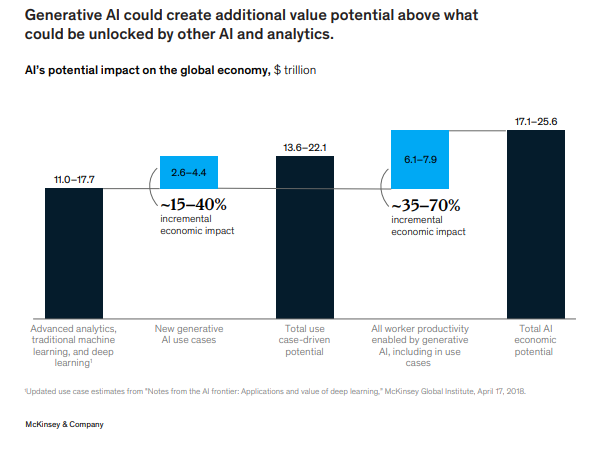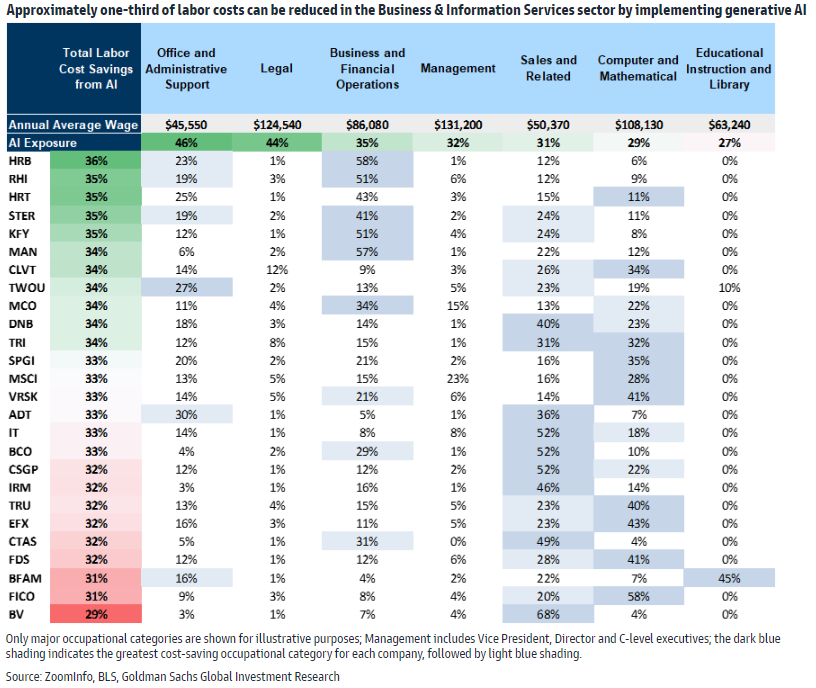🤖 Brace yourself: The AI jobs panic is about to explode
Two new reports suggest generative AI will have a big impact on knowledge workers. (And that's OK.)
⭐ First things first, I have a great offer for all my free subscribers: a full-year subscription for just $1 a month. That works out to a whopping 80 percent discount from the usual $60 a year. That’s right, just a buck a month for the next 12 months, or $12 for 12 months. This offer won’t last long!
It’s going to be a fascinating time as emerging technologies such as generative AI continue to emerge amid a year sure to be full of surprises, both economic and political. What’s going to happen next? Let’s find out together as we work to create a better world.
Melior Mundus
Quote of the Issue
"AI is an amplifier of human intelligence and when people are smarter, better things happen: people are more productive, happier, and the economy thrives." - Yann LeCun
The Essay
🤖 Brace yourself: The AI jobs panic is about to explode
While extreme AI doomers will no doubt continue to intensely focus on the supposed existential threat posed by generative AI, particularly large language models, I think concerns about job loss are ready to dominate the conversation on social media and coverage by traditional media outlets. My candidate for a key catalyst is a new report from the McKinsey Global Institute, “The economic potential of generative AI.” While The New York Times went with the upbeat “Generative A.I. Can Add $4.4 Trillion in Value to Global Economy, Study Says,” for a headline, this Bloomberg hed gives a hint of hysteria to come, “Biggest Losers of AI Boom Are Knowledge Workers, McKinsey Says.” I have a feeling that alarming angle is going to catch on. From Bberg:
The transformation will pile pressure on the labor force, especially for higher-wage knowledge workers whose activities “were previously considered to be relatively immune from automation,” the report said. A few years ago, McKinsey had estimated that about half of worker hours worldwide were spent on tasks that could be automated. Now it’s raising the figure to as high as 60-70%. Employees could find that their time is reallocated — or that their jobs disappear. “Workers will need support in learning new skills,” the report said. “Some will change occupations.”
Question: If new technologies can perform part of your current job (allowing you to do higher productivity and/or more creative tasks) or even your entire job — or to put it another way, tasks previously performed by labor to be produced by capital — are you a “loser?” Such framing equates any and all change with loss. If that were truly the case, workers have been losing for more than two centuries. Yet our current prosperity is built on disruption. Indeed, McKinsey estimates that the 63 use cases spanning 16 business functions for GenAI that it has identified could deliver $3 trillion to $4 trillion in global economic benefits. And that’s in addition to the $11 trillion to $18 trillion of economic value that McKinsey estimates nongenerative AI analytics could generate.
Then there are the potentially massive productivity gains: “Generative AI could enable labor productivity growth of 0.1 to 0.6 percent annually through 2040, depending on the rate of technology adoption and redeployment of worker time into other activities. Combining generative AI with all other technologies, work automation could add 0.2 to 3.3 percentage points annually to productivity growth.”
Industries rise and fall, jobs come and, the tasks performed in the production of products may change, sometimes favoring capital, other times labor. Such is economic history. But there’s a difference with generative AI, according to McKinsey, because of its ability to understand and use natural language for a variety of tasks … “particularly activities involving decision making and collaboration, which previously had the lowest potential for automation.”
Driving all of this is AI acceleration. MGI had previously identified 2027 as the earliest year when “median human performance for natural language understanding” might be achieved. But in this new analysis, the corresponding point is 2023. Now. From the report:
Previous generations of automation technology often had the most impact on occupations with wages falling in the middle of the income distribution. For lower-wage occupations, making a case for work automation is more difficult because the potential benefits of automation compete against a lower cost of human labor. Additionally, some of the tasks performed in lower-wage occupations are technically difficult to automate—for example, manipulating fabric or picking delicate fruits. Some labor economists have observed a “hollowing out of the middle,” and our previous models have suggested that work automation would likely have the biggest midterm impact on lower-middle-income quintiles. However, generative AI’s impact is likely to most transform the work of higher-wage knowledge workers because of advances in the technical automation potential of their activities, which were previously considered to be relatively immune from automation.
Overall, McKinsey sees 75 percent of the value from businesses using GenAI coming from four business functions:
Customer operations. For example: Customers could interact with a humanlike chatbot that delivers an immediate, personalized responses to complex inquiries, ensuring a consistent brand voice regardless of customer language or location), Marketing and sales. For example: Sales and marketing professionals could efficiently gather market trends and customer information from unstructured data sources and draft effective marketing and sales communications).
Software engineering For example: Software engineers and product managers use GenAI to assist in analyzing, cleaning, and labeling large volumes of data, such as user feedback, market trends, and existing system logs, and research and development.
Product R&D. For example: Researchers could use GenAI to generate prompt-based drafts and designs, allowing them to iterate quickly with more design options.
And here’s a specific example about product R&D:
For example, the life sciences and chemical industries have begun using generative AI foundation models in their R&D for what is known as generative design. Foundation models can generate candidate molecules, accelerating the process of developing new drugs and materials. Entos, a biotech pharmaceutical company, has paired generative AI with automated synthetic development tools to design small-molecule therapeutics. But the same principles can be applied to the design of many other products, including larger-scale physical products and electrical circuits, among others.
As it turns out, Goldman Sachs also just did a big report on the job impact of GenAI, focusing on the business and information services sector. So we’re talking about companies such as S&P Global, Moody’s, H&R Block, Manpower Group, and ADT among many others. In “Evaluating the impact of generative AI across Business & Info Services,” Goldman analysts scored companies on two dimensions; the subjectivity and creativity of their content or services, and the proprietary or commoditized nature of their content or services. The theory here is that GenAI can enhance subjective and proprietary content or services, but can disrupt rules-based and commoditized content or services. From the Goldman report
Based on our framework, we believe that generative AI can unlock a meaningful amount of opex savings in the Business & Info Services sector as headcount requirements for certain occupations go do down and productivities increase. Our analysis shows that 29-36% of labor costs in the sector could be eliminated by generative AI. Companies providing repetitive and rule-based services, such as tax preparation, background checks and staffing, could potentially benefit more from labor replacement than industry peers, with labor cost reduction potential totaling 35-36%.
Nothing in either of these reports necessarily means a faster growing and higher productivity economy will also mean one with higher unemployment, although there may be more job changing, more dynamism. If so, as MGI notes, “workers will need support in learning new skills.” But history suggests that general purpose technologies — and AI/machine learning/GenAI sure look like one — have a history of broadly improving human welfare even as they also unpredictably change what humans spend their days doing. Both of the recent periods of rapid productivity and economic growth, the 1960s and 1990s, were also ones of rapid job growth. There’s no reason yet to think another tech-driven boom will be any different.
Micro Reads
▶ Artificial Artificial Artificial Intelligence: Crowd Workers Widely Use Large Language Models for Text Production Tasks - Veniamin Veselovsky, Manoel Horta Ribeiro, and Robert West, Arxiv | Large language models (LLMs) are remarkable data annotators. They can be used to generate high-fidelity supervised training data, as well as survey and experimental data. With the widespread adoption of LLMs, human gold standard annotations are key to understanding the capabilities of LLMs and the validity of their results. However, crowdsourcing, an important, inexpensive way to obtain human annotations, may itself be impacted by LLMs, as crowd workers have financial incentive to use LLMs to increase their productivity and income. To investigate this concern, we conducted a case study on the prevalence of LLM usage by crowd workers. We ran an abstract summarization task from the literature on Amazon Mechanical Turk and, through a combination of keystroke detection and synthetic text classification, estimate that 33–46% of crowd workers used LLMs when completing the task. Although generalization to other, less LLM-friendly tasks is unclear, our results call for platforms, researchers, and crowd workers to find new ways to ensure that human data remain human, perhaps using the methodology proposed here as a stepping stone.
▶ IBM quantum computer beat a supercomputer in a head-to-head test - Karmela Padavic-Callaghan, New Scientist |
▶ Europe moves ahead on AI regulation, challenging tech giants’ power - Cat Zakrzewski and Cristiano Lima, The Washington Post |
▶ Sam Altman Asked For AI Rules. The EU Answered. - Lionel Laurent, Bloomberg Opinion |
▶ NEPA Timelines for Clean Energy Projects: Understanding Delays in Clean Energy Development - Jennifer Morales and Steffen Rigby, Center for Growth and Opportunity |
▶ The Awkward Partnership Leading the AI Boom - Tom Dotanand Deepa Seetharaman, The Wall Street Journal |









